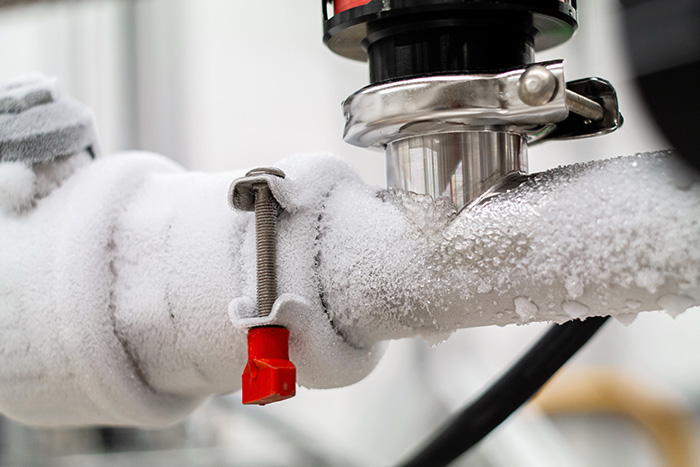Essential Advice to Prevent Frozen Plumbing in Cold Weather
Essential Advice to Prevent Frozen Plumbing in Cold Weather
Blog Article
Do you find yourself looking for resources concerning Preventing and dealing with frozen pipes?

Winter can damage your plumbing, specifically by freezing pipes. Below's how to stop it from occurring and what to do if it does.
Introduction
As temperature levels drop, the danger of frozen pipes rises, potentially resulting in pricey repair work and water damages. Understanding exactly how to stop frozen pipes is vital for homeowners in chilly climates.
Comprehending Icy Pipelines
What creates pipelines to freeze?
Pipes freeze when subjected to temperature levels listed below 32 ° F (0 ° C) for expanded durations. As water inside the pipelines ices up, it increases, taxing the pipeline wall surfaces and possibly triggering them to burst.
Threats and problems
Frozen pipelines can cause water supply disturbances, residential property damage, and costly repairs. Ruptured pipelines can flood homes and cause substantial architectural damage.
Indications of Frozen Pipes
Determining icy pipelines early can prevent them from rupturing.
Exactly how to recognize icy pipelines
Try to find reduced water flow from faucets, uncommon odors or sounds from pipes, and visible frost on revealed pipes.
Prevention Tips
Shielding susceptible pipelines
Wrap pipes in insulation sleeves or make use of heat tape to safeguard them from freezing temperature levels. Concentrate on pipelines in unheated or external areas of the home.
Heating methods
Maintain indoor rooms properly heated up, especially areas with plumbing. Open cupboard doors to enable warm air to distribute around pipelines under sinks.
Securing Outside Pipes
Yard pipes and outside taps
Detach and drain garden hoses prior to winter months. Mount frost-proof faucets or cover exterior taps with insulated caps.
What to Do If Your Pipes Freeze
Immediate activities to take
If you think icy pipes, maintain taps open up to alleviate stress as the ice melts. Utilize a hairdryer or towels taken in hot water to thaw pipelines gradually.
Long-Term Solutions
Structural modifications
Take into consideration rerouting pipes far from outside walls or unheated areas. Add additional insulation to attic rooms, cellars, and crawl spaces.
Upgrading insulation
Invest in top notch insulation for pipelines, attics, and walls. Appropriate insulation assists keep constant temperature levels and lowers the risk of icy pipelines.
Conclusion
Avoiding frozen pipes needs positive actions and quick reactions. By comprehending the reasons, indicators, and safety nets, homeowners can shield their pipes throughout winter.
5 Ways to Prevent Frozen Pipes
Drain Outdoor Faucets and Disconnect Hoses
First, close the shut-off valve that controls the flow of water in the pipe to your outdoor faucet. Then, head outside to disconnect and drain your hose and open the outdoor faucet to allow the water to completely drain out of the line. Turn off the faucet when done. Finally, head back to the shut-off valve and drain the remaining water inside the pipe into a bucket or container. Additionally, if you have a home irrigation system, you should consider hiring an expert to clear the system of water each year.
Insulate Pipes
One of the best and most cost-effective methods for preventing frozen water pipes is to wrap your pipes with insulation. This is especially important for areas in your home that aren’t exposed to heat, such as an attic. We suggest using foam sleeves, which can typically be found at your local hardware store.
Keep Heat Running at 65
Your pipes are located inside your walls, and the temperature there is much colder than the rest of the house. To prevent your pipes from freezing, The Insurance Information Institute suggests that you keep your home heated to at least 65 degrees, even when traveling. You may want to invest in smart devices that can keep an eye on the temperature in your home while you’re away.
Leave Water Dripping
Moving water — even a small trickle — can prevent ice from forming inside your pipes. When freezing temps are imminent, start a drip of water from all faucets that serve exposed pipes. Leaving a few faucets running will also help relieve pressure inside the pipes and help prevent a rupture if the water inside freezes.
Open Cupboard Doors
Warm your kitchen and bathroom pipes by opening cupboards and vanities. You should also leave your interior doors ajar to help warm air circulate evenly throughout your home.
:strip_icc()/snow-outdoor-faucet-pipes-4af65d1e5e904fb1aa7bf74071fe5d89.jpg)
Do you enjoy reading about How to Prevent Your Pipes From Freezing? Place a comment further down. We'd be happy to find out your insights about this review. In hopes to see you back again later on. Sharing is nice. Who knows, you may very well be doing someone a favor. We love your readership.
Click Here Report this page